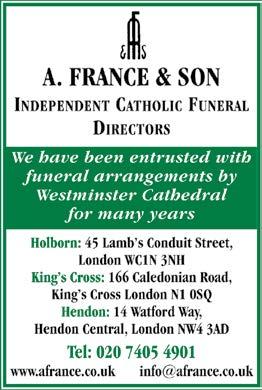Westminster Cathedral Magazine

If you can, please make a donation for your copy to cover its production cost. Thank you.


If you can, please make a donation for your copy to cover its production cost. Thank you.

Although we earn income from the advertising which we carry, Oremus relies on donations from readers to cover its production costs.
The Companions of Oremus was established to recognise those who give generously to support us. Open exclusively to individuals, Companions’ names are published in the magazine each month (see page 7). All members are invited to one or more social events during the year and Mass is offered for their intentions from time to time.
If you would like to support us by joining the Companions, please write to Oremus, Cathedral Clergy House, 42 Francis Street, London SW1P 1QW or email oremuscomps@rcdow.org.uk with your contact details, including postcode. Members are asked to give a minimum of £100 annually. Please mention how you would like your name to appear in our membership list and if you are eligible to Gift Aid your donation. Postal subscriptions to Oremus may be purchased by completing and sending to the office the coupon printed in the magazine. Subscriptions to receive Oremus either by email (free) or as hard copy by post (p & p payable) can also be entered by visiting https://westminstercathedral.org.uk/the-cathedral-community/about-oremus/ and completing the form there.
Thank you for your support.
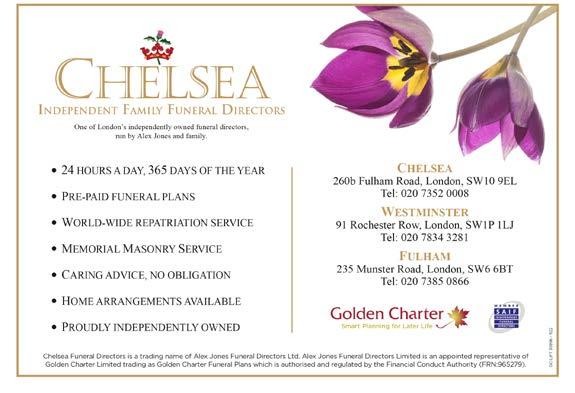
Cathedral Clergy House
42 Francis Street
London SW1P 1QW
T 020 7798 9055

E oremus@westminstercathedral.org.uk
W www.westminstercathedral.org.uk
Oremus, the magazine of Westminster Cathedral, reflects the life of the Cathedral and the lives of those who make it a place of faith in central London. If you think that you would like to contribute an article or an item of news, please contact the Editor.
Patron
The Cardinal Archbishop of Westminster
Chairman
Fr Sławomir Witon´
Editor
Lorcán Keller
Oremus Team
Tony Banks – Distribution
Marie Carne – Content Compilation
Ellen Gomes – Archives
Zoe Goodway – Marketing & Finance
Paul Moynihan – Proofreading
Manel Silva – Subscriptions
Design and Art Direction
Julian Game
Registered Charity Number 233699 ISSN 1366-7203
Opinions expressed by contributors do not necessarily represent the views of the Editor or the Oremus Team. Neither are they the official views of Westminster Cathedral. The Editor reserves the right to edit all contributions. Publication of advertisements does not imply any form of recommendation or endorsement. Unless otherwise stated, photographs are published under a creative commons or similar licence. Every effort is made to credit all images. No part of this publication may be reproduced without permission.

A rare view of the Blessed Sacrament Chapel from behind the tabernacle, following months of cleaning and restoration. Pictured atop the tabernacle, and again over the Chapel gates, is a ‘pelican in her piety’. It was traditionally believed that when food was scarce, a mother pelican would vuln her breast, thus sacrificing herself to feed her young. Naturally this became a symbol of Christ’s Sacrifice in the Eucharist.
Cathedral Life: Past & Present
From the Cardinal 4
The Blessed Sacrament returns home 6 & 7
Mr O’Brien and Alex in conversation 12 & 13
Advent Sunday Homily by the Latin Patriarch of Jerusalem 16 & 17
Cathedral History in Pictures: The Funeral of Cardinal Francis Bourne, Archbishop of Westminster by Paul Tobin 22
L’Orgue Spirituel 27
A phoenix from the ashes by Bishop Nicholas Hudson 8 & 9
The Genesis of the new translation of the Second Edition of the Lectionary by Archbishop George Stack 10 & 11
Holy Years – a short history by Louise Sage 14
‘Next year in Jerusalem!’ by Mgr Vincenzo Peroni 15
Blessed Carlo Acutis in Westminster by Bishop Nicholas Hudson 23
The Friends 13
In Retrospect: 100 and 70 years ago 19
Monthly Album 20 & 21
Diary and Notices 24 & 25
Poem and Crossword 26





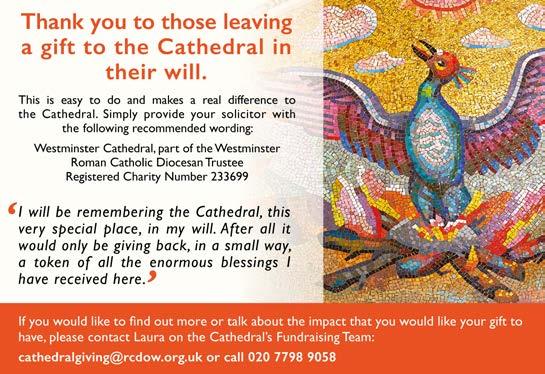


By the time you read these words, the Jubilee Year called by Pope Francis will be underway. It is the 27th such year since the first, proclaimed by Pope Boniface VIII in 1300. The theme for the 2025 Jubilee is ‘Pilgrims of Hope’. As St Paul reminds us, and as Pope Francis begins the Bull of Indiction for the Jubilee, ‘Hope does not disappoint.’ (Romans 5:5). As 2025 begins, there is much in the world that, seen through our eyes alone, gives us cause for much disquiet. So it is more important than ever to take these words of St Paul to our hearts and try to remain firm in hope.
Pilgrimage is, and has long been, a characteristic of Jubilee Years. A traditional Holy Year pilgrimage is often to Rome, but it may be more local too. I encourage you to participate in a pilgrimage of some sort this year. It can be an opportunity to reflect on our own journeys of faith, as individuals and communities. ‘The greatest danger in mission’, writes Pope Francis, ‘is that amid all the things we say and do, we fail to bring about a joyful encounter with the love of Christ who embraces us and saves us’ ( Dilexit Nos, 208). Pilgrimage can so often provide us with that space we need for renewal in our relationship with Christ.
And from that renewed relationship so much can flow, helping us to deepen our friendship with the Lord, and become more effective beacons of hope in a world that needs our compassion, practical witness and prayer as never before.
‘Rejoice’, says Jesus, ‘that your names are written in heaven.’ (Luke 2:20). That is, we pray, the fulfilment of all our earthly pilgrimages. That is the truest of reasons to hope, this Jubilee Year and always.

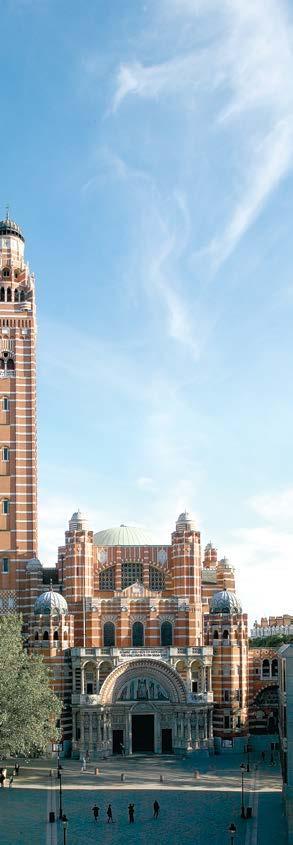
Westminster Cathedral
Cathedral Clergy House
42 Francis Street
London SW1P 1QW
Telephone 020 7798 9055
Email chreception@rcdow.org.uk
www.westminstercathedral.org.uk
Cathedral Chaplains
Fr Sławomir Witoń, Dean
Fr Brian O’Mahony, Sub-Dean
Fr Patrick van der Vorst, Precentor
Fr John Scott, Registrar
Fr Vincent Mbu’i SVD
Fr Hugh MacKenzie
Fr Javier Ruiz-Ortiz (priest in residence)
Also in residence
Franciscan Sisters of Our Lady of Victories:
Sr Jesuina, Sr Angelina and Sr Fatima
Music Department
Simon Johnson, Master of Music
Peter Stevens Obl. OSB, Assistant Master of Music
Daniel Greenway, Organ Scholar
Cathedral Manager
Peter McNulty
Estates Manager
Stuart Doxey
Finance Manager
George Kulasingham
Fundraising Manager
Awaiting appointment
Chapel of Ease
Sacred Heart Church
Horseferry Road SW1P 2EF
With thanks to the Sir Harold Hood Foundation and the American Friends, the Blessed Sacrament Chapel and the Shrine of the Sacred Heart and St Michael received a deep clean, which lasted several months. During this time, a tabernacle was placed in the Lady Chapel, where Our Lord sojourned before returning home. Perhaps this gave a new meaning to the prayer, Sub tuum præsidium (We fly to thy protection, O Holy Mother of God), written in mosaics around the altarpiece?
Upon completion, the newly cleaned chapels were left empty for the weekend, in order to allow people to admire the mosaics, without inconveniencing those who gather before the Blessed Sacrament in prayer.




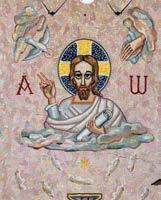

We are very grateful for the support of the following:
Leticia Dominguez Abada
Lally Ambatali
Keith Best
Dr Stuart Blackie
Anne Veronica Bond
Lolita Botanes
Richard Bremer
Lorenzo Cabrelli
Ms Virginia Pinto Cassama
Mrs Erlinda Chin
Francis George Clark
R & L Collyer-Hamlin
Daniel Crowley
Angelita Caronan Duran
Cora Emflorgo
Ms Georgina Enang
Fr Joseph Farrell K.H.S. Golden
Jubilee
Fred Gardiner
William Gardner-Hunter
Connie Gibbes
Zoe & Nick Goodway
Rosalinda Grimaldo
Agnes Haein Kim
Mrs Valerie Hamblen
Bernadette Hau
Mrs Cliona Howell
Alice M Jones & Jacob F Jones
Poppy K
Rosanne Kay
Mary Thérèse Kelly
John Langan
David Lawton
Raymund Livesey
Alan Lloyd in memoriam
Clare and John Lusby
Linda McHugh
Christiana Thérèse Macarthy-Woods
Ms Ludivina Mangmang
James Maple
Paul Marsden
Mary Maxwell
Dr George Morris
Abundia Toledo Munar
Euphrasie Mundele Kilolo
Chris Stewart Munro
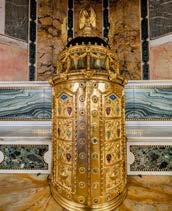

Mrs Brigid Murphy
Kate Nealon
Cordelia Onodu
Cris Ragonton
Alan Rainer
Clementina Rokosu
Precy Salvador
John Scanlan
Veronica Scrope
Sonja Soper
Tessa and Ben Strickland
Yollie Sumayod
Julia Sutherland
Eileen Terry
Robin Michael Tinsley
Lucila Torrefiel
Peter W Wilson and of our anonymous Companions
If you would like to become a Companion of Oremus, see page 2
Bishop Nicholas Hudson, Episcopal Secretary of the Bishops’ Conference, represented Cardinal Vincent Nichols at the Solemn Reopening and Dedication of Notre Dame Cathedral in Paris on Saturday, 7 December 2024.
Bishop Nicholas Hudson
I was touched to be asked to represent Cardinal Nichols and the Bishops’ Conference of England and Wales at the Solemn Reopening and Dedication. I have known Notre Dame Cathedral all my life; my mother was Paris-born and would take us there as often she could.
As children, we were deeply fond of Notre Dame, but we were always surprised at how dark it was, both inside and out. For those of us privileged to witness its reopening, it was a joy to enter now a cream-white cathedral, brighter than one could ever have imagined it, and yet still the same dear Notre Dame. We told one another, ‘This is what it must have been like to enter a new Gothic cathedral in the Middle Ages!’
The new elements I immediately liked. We were welcomed at the west door by a massive bronze font, which carries the eye upwards and forwards to the equally imposing bronze altar, and still further up to the great gold cross which survived the fire and surmounts the newly dedicated tabernacle. To the right of the altar stands a yet more unlikely survivor, the fourteenth century statue of Our Lady of the Pillar. Unlikely, because she stood only feet away from where the spire had crashed to the cathedral floor that fateful night in 2019. Surely it was Divine Providence which had saved her, we told one another. She was rightly the main focus and channel of our prayers in the reopening ceremony.
The ceremony began with the tolling of Notre Dame’s greatest bell. This sound was matched later in the evening by another sound, the ‘reawakening’ of the
organ. The Archbishop of Paris, Laurent Ulrich, addressed the organ personally: ‘Organ, sing now the praise of God the Father,’ and the organ awoke. ‘Organ, sing now the praise of God the Son, […] of God the Spirit, […] of God’s Mother Mary, Notre Dame’; and the organ responded differently to each of his commands.
Before the organ sounded, we witnessed perhaps a still more powerful moment, when the cathedral was filled with firemen and women, who paraded the length of the cathedral in bright red uniform, brass helmets under their arms, at last to take their bow to lengthy, lengthy applause, from princes, presidents, prime ministers, bishops, priests, the blind and the lame, and people with learning disabilities (these guests had pride of place, with frontrow seats), and countless others. Many shed a tear, firefighters included. Due honour was also paid to the countless artisans who had made possible this raising of a phoenix from the ashes, in just five short years.
To return the next morning for the Inaugural Mass and Dedication of the Altar was an ‘embarras de richesses’, as the French would say, an ‘embarrassment of riches’. Everything about it was eloquent. There was a great bronze boom as the Archbishop lowered into the heart of the altar the relics of French saints; Saints Catherine Labouré, Charles de Foucauld, and Madeleine Sophie Barat, to name but three, before sealing. The long, generous anointing of this massive, bare, bronze mensa to exquisite music felt like the anointing of Christ’s very body. Finally the altar was lovingly dressed and adorned for the celebration of an intensely prayed Eucharist.\
Standing around the altar with a great number of bishops from France, along with bishops from Ireland and the United States, I prayed, of course, for my family and for the Church’s ‘eldest daughter’, the Church in France. I prayed also for ‘Our Lady’s Dowry’, the Church in England and Wales, that we might all grow in our devotion to Christ and his Blessed Mother, Notre Dame.
I was pleased to note the presence of at least two other Englishmen in the cathedral; His Royal Highness the Prince of Wales, and Sheffield-born Brother Matthew, Prior of Taizé, whom I sat alongside at the reopening. Prince William’s presence called to mind the crowning of two British monarchs in that place: Henry VI of England and Mary Queen of Scots. Brother Matthew and I told each other how deeply privileged we felt to be present, representing our country at such an important moment, not only for France, but for the world. We were thanked time and again by the French bishops for coming to support this historic act.
That we had witnessed an event of worldwide cultural and religious significance was amplified by Archbishop Ulrich’s closing remarks, when he chose to say that Notre Dame is reborn not just for France, not just for the Church, but for the world. ‘Whatever your relationship to Notre Dame,’ he said, ‘whether you are baptised, or seeking baptism, or not certain what you believe, know that you are welcome – welcome to linger, be still and drink in all that is given here.’ I think the numbers who come to Notre Dame in future years will be great indeed, and swell mightily the 10 to 15 million who visited annually, before the fire.

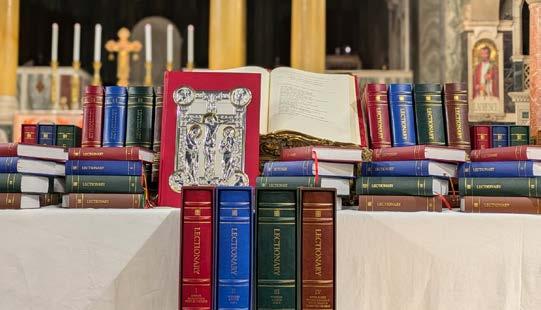
You will remember I used the word ‘contemporary’ in the last article, to put biblical thoughts and words into modern language. That methodology or style of translation is called ‘functional’ or ‘dynamic equivalence’. It seeks to capture the ideas of the original author of the text, the movement and direction of the text. As I say, it is to put the ideas, the words and phrases, into a contemporary, modern, accessible, even simple language. You may think that J B Phillips, the Anglican scripture scholar working in the 1970s, took this dynamism too far in his New Testament for Modern Man. Here, he translates the words of Jesus in Luke 14:10, ‘Friend go higher’, as ‘My dear fellow, we have a much better seat for you’. He translates the beautiful words of Paul in 2 Corinthians, ‘Greet each with a holy kiss’ as ‘A handshake all round please’. Those of you familiar with the excellent work by Bishop Tom Wright, The New
Testament for Everyone, will recognise a more recent approach to dynamic equivalence. This approach to translation was championed by the godfather of modern biblical translation, an American linguist called Eugene Nida (1914-2011) who, although not a biblical scholar, was an expert in linguistic analysis.
Like all methods of translation, dynamic equivalence has its critics and its supporters. There is no perfect translation of the Bible. Every translation contains some ‘trade off’ as to what the original language and the original meaning are saying to us today. This includes the historical experiences and the faith of biblical characters, those who recorded them, and those who have translated these texts down the ages. How does one go about capturing the eternal message and the revelation of God, in a time, language, and faith experience two or three thousand
years removed from the source? The critics of the dynamic equivalence method say it smooths down the text, and therefore loses some of the theological nuances. In short, they say this method seeks to ‘bring the Bible to the reader, and not the reader to the Bible.’ On the other hand, its supporters would argue that it makes the Bible accessible to the ordinary reader. The style and translation method of our recent Lectionary was that of dynamic equivalence, first used in the 1966 English edition of the Jerusalem Bible. The third edition of the Revised New Jerusalem Bible was published in 2019.
Another method, or approach, to translation is that of ‘formal equivalence’, what might be described, if somewhat pejoratively, as ‘word for word’. As I mentioned earlier, no translation or method is beyond criticism, nor can it be crudely word for word. It must seek
to express, as faithfully as possible, the text, meaning and nuances of the original language and author. The style of the English Standard Version Catholic Edition (ESV-CE) is that of formal equivalence. It comes from a different school, a different family, a different methodology of translation, originating with the King James Bible, or ‘Authorised Version’ of 1611. This was commissioned by King James I of England (VI of Scotland), as a means of resolving the tension between the Calvinist Geneva Bible, and the Bishops’ Bible, representing what we would now call High Church Anglicanism. In parenthesis, it is important to note that Catholics were also engaged in their own translation of the Bible. Like their Protestant contemporaries, the notes produced in the margins were often polemical in defence of Counter Reformation positions. It was not until 1749 that our own saintly Bishop Richard Challoner, now buried in Westminster Cathedral, produced an updated translation of the original Douay-Rheims Bible, published between 1582 and 1609. Challoner’s translation remained the staple diet of Catholic worship until the twentieth century. It is said that he consulted the King James Bible, in conjunction with other texts, in his compilation of his own magnum opus.
The Authorised Version, in turn, gave birth to the Revised Standard Version of the Bible, and the English Standard Version. In 2011, the English Standard Version, Catholic Edition was chosen by the Bishops of England and Wales, and those of Scotland, for the Lectionary which we have been using since the First Sunday of Advent, 1 December 2024. Part of the rationale behind this choice were the two pivotal documents from the Holy See on the principles of liturgical and biblical translation. The first was Liturgiam Authenticam (2001) which encouraged ‘an approach to the translation of liturgical texts that sees it not so much as a work of creative inventiveness as one of fidelity and exactness in rendering the texts
into vernacular languages’, thus preserving the identity and unity of the Roman Rite. The second document was Pope Francis’ 2017 Motu Proprio, Magnum Principium, identifying the ‘three fidelities’ to be observed in liturgical translation: fidelity to the original text, fidelity to the receptor language and fidelity to the intelligibility of the text for the recipients. Let me compare and contrast one or two texts translated, according to the different methods, so that you may understand the various nuances these methodologies bring to the task of translation.
In the Old Testament Book of Numbers, chapter 12 (6-8), Aaron and Miriam, the brother and sister of Moses, are critical of Moses’ marriage to a Cushite woman. They claim that God also speaks through them, and God invites them to the Tent of Meeting. He speaks to them in the dynamic equivalent language of the Jerusalem Bible:
‘Listen to my words! If there is a prophet among you, I make myself known to him in a vision, I speak to him in a dream. Not so with Moses; to him my whole household is entrusted; to him I speak face to face, plainly and not in riddles.’
‘Face to face’ could signify disquiet, disapproval, confrontation. ‘Mouth to mouth’ signifies a different experience. The uniqueness of God’s communication is mouth to mouth; the breath of God. It speaks of intimacy, every word comes from the mouth of God, through the mouths of prophets. Ultimately Jesus opened his mouth and spoke. ‘Man shall not live by bread alone but by every word that comes from the mouth of God’ (Matt 4:4). All these things Jesus said to the crowds in parables. This was to fulfil what was spoken by the prophets: ‘I will open my mouth in parables; I will utter what has been hidden since the foundation of the world’ (Matt 13:35).
The formal equivalent ESV-CE of the same text reads:
‘Hear my words: If there is a prophet among you, I the Lord make myself known to him in a vision. I speak with him in a dream. Not so with my servant Moses. He is faithful in all my house. With him I speak mouth to mouth, clearly, not in riddles.’
Another example of dynamic equivalent translation, this time the Sermon on the Mount in our former Lectionary (Matt 5:1-12), the Jerusalem Bible:
‘Seeing the crowds, he went up the hill. There he sat down and was joined by his disciples. Then he began to speak. This is what he taught them:’
The Revised New Jerusalem Bible (2019) puts it slightly differently when it says:
'Seeing the crowds, he went onto the mountain. And when he was seated, his disciples came to him. Then he began to speak. This is what he taught them.’
The formal equivalent translation as contained in the current Lectionary (ESV-CE) reads as follows:
‘Seeing the crowds, he went up on the mountain, and when he sat down, his disciples came to him. And he opened his mouth and taught them, saying:’
This is a theological mountain, not a hill. Moses ‘went up God’ and God ‘called to him from the mountain’ (Exodus 19:3). This is Mount Sinai, the place where God spoke to Moses ‘from the mountain’, the mountain where the faith of God’s people was proclaimed and communicated. Likewise, for Jesus this is a theological mountain, not a hill. Jesus was not ‘joined by his disciples’. His disciples ‘came to him’. He ‘opened his mouth’ rather than ‘began to speak’ indicating he spoke with divine authority.
Thank you, Alex, for agreeing to share some of your experience in Westminster Cathedral Choir School. This is the first in, what we hope will be, a series of articles for Oremus magazine, and where better to begin than with our Head Chorister.
So, at thirteen years old, you are one of the oldest choristers in the Choir. What difference does it make, being so senior?
First of all, responsibility. As a Year 8 you’re expected to lead the Choir, and to be a good role model and example to the younger choristers. Also, musically; when you are younger you are learning how to sing and read music, which builds up to being an allround good musician in later years.
What does your role as Head Chorister involve?
It involves leading the choristers, not just in singing, but also things like having good manners to set the example to the younger boys. I am expected to lead with the singing but I don’t hog the solos.
How did you come to be a chorister here?
I was an ordinary boy who went to St Gregory’s Catholic Primary School in Greenford. My mum is a music teacher and she saw the opportunity to become a chorister. She asked me whether I wanted to give it a go and I thought why not? I didn’t do that much music before coming here, but I enjoyed it. Becoming a chorister was quite an easy process. I came and did an audition, visited the boarding house which was quite nice, a fun memory. The other boys were very friendly and kind, which helped a lot.
What are your favourite times of the year?
Of course I really look forward to Christmas – the Christmas Celebrations and Midnight Mass are highlights. And Easter of course, with all the big services, and the Cathedral full. It somehow feels bigger in size when it’s full, and you can look down into a sea of people in the nave. It’s quite extraordinary.
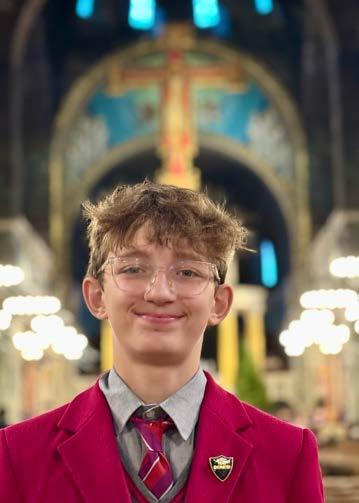
Many people might not realise that the choristers are all boarders. What’s that like and is it something you enjoy?
I do enjoy boarding. I haven’t had bad homesickness. The people are nice, and I have friends. The food is actually really good. My favourite thing is a desert: the Chocolate Volcano is sumptuous!
What can you tell us about Mr Johnson, the Master of Music, and Mr Stevens, the Assistant Master of Music?
Well, both of them have helped me and the Choir because they teach us, and they encourage us. They are nice. As teachers, they don’t look badly on mistakes – they want you to improve, so they take you through step by step and correct any mistakes. It’s a good method.
Have you travelled much as a chorister? And there are some exciting tours coming up this year?
In my past few years I’ve been to Germany twice, and Italy, and done recordings at Buckfast Abbey. It’s a great experience to tour with the Choir and I’m excited because in my last year here we are doing three tours! We are going to the USA, Hungary and Italy.
I don’t expect many boys or girls your age listen to much choral music. Are you a big fan?
I do actually enjoy the music we sing. Choral music is so full; it’s the highlight of my music endeavour. It has so much meaning to it. You can find things that you can’t find in other types of music.
The Choir of Westminster Cathedral is world-famous. What do you put that down to?
I put that down to commitment and confidence. If you are committed, you feel that it’s in your hands; that’s it really. We
have a really distinctive sound and the music that we sing helps with that.
You sing music from many different centuries – what are your preferences?
I do quite like Renaissance music, and we sing a lot of that. My three favourite pieces are Vigilate by William Byrd, which we sang last year at Christmas. Second would be Tribue, Domine also by Byrd, but my favourite is from a different period, the St John Passion.
As a chorister you also attend Westminster Cathedral Choir School, alongside other choristers and day boys. How does that work?
The school is quite nice actually. It’s a good environment. The choristers are as one with the prep school, so both sides of the school are harmonious. It’s also nice to have the day boys there because they make our year group bigger and we have a better mix and better football matches.
With over 1.5 million visitors a year, the Cathedral’s parquet flooring endures rather a lot of wear and tear. In order to restore and protect it from future damage, The Friends volunteered to raise the estimated £125,000, doing so in less than a year.
Much of this work was, naturally, behind the scenes, carried out by a dedicated team of volunteer council members, and one part-time member of staff. Despite having day jobs and various other commitments, we successfully orchestrated two ‘Big Give’ campaigns in 2024; at Easter and Christmas. This would not have been possible without the extraordinary generosity of the Friends’ membership base and our supporters among the wider Cathedral community and beyond.
Many people will be staggered by what you have achieved by the age of thirteen. Would you say that becoming a chorister is a life-changing experience?
I think my life would have been very different without this opportunity. You don’t have to be already an outstanding singer to become a chorister. You can just be an ordinary boy who wants to sing. Life does change because, when you are in the Choir, you start to feel the commitment and that you can sing; you know how to sing in that Choir, so it becomes a commitment and you quite like it.
Interview by Mr Robert O’Brien, Deputy Head (Academic) and Head of Boarding at WCCS. For further information about becoming a chorister at Westminster Cathedral, please contact Lucy Freeman at lfreeman@choirschool.com.


With thanks to the enormous generosity of The Big Give, Sir Alec Reed and the Reed Foundation, and a small number of private donors, we were able to double your 356 donations, across the two campaigns. Without their help and support, and your generosity, these campaigns would not be possible.
At Easter we sought £25,000 (doubled to £50,000), you offered £26,381. At Christmas we aimed for £32,500 (doubled to £65,000), which was reached exactly, with 14 minutes to spare! With Gift Aid, we have exceeded the £125,000 estimated cost, with enough of a margin to cover any unforeseen costs and/ or initial maintenance. A profound thank you to everyone who helped to support this Cathedral we love so dearly!
The primary function of The Friends is to support Westminster Cathedral,
Cathedral Hall and Clergy House. We do so particularly, although not exclusively, through repair projects and capital improvement. Whether big or small, your donations have allowed us, in less than a year, to restore 1,800m2 of parquet flooring. You will, by now, have seen the marked improvement on the side aisles. The same treatment will be next applied to the nave in 2025.
This year, our fundraising efforts will continue in earnest, and I look forward to sharing more in due course. There will also be many more social and cultural events, so please keep an eye on the newsletter and online. We hope that you will join us.
To find out more, email Joe at friends@rcdow.org.uk.
Happy New Year!

Louise Sage
The concept of a Holy Year, or Jubilee, goes back to the Old Testament when Moses declared every fiftieth year as a time to be observed by all of Israel (Leviticus 25:8-13), when slaves and prisoners would be freed, debts forgiven, and the mercy of God would be extended to all.
In the Catholic Church the first Jubilee, proclaimed by Pope Boniface VIII in 1300, was instigated for the granting of forgiveness and indulgence to all who confessed, repented of their sins, and visited St Peter’s Basilica. This practice involved visiting St Peter’s once a day for 30 days, for Romans, or 15 days for non-Romans, and was later extended to also include St Paul Outside the Walls and the other major basilicas. In 1470, Pope Paul II chose to increase the frequency of the Jubilee to just twentyfive years.
I thought it would be interesting to look at some fascinating facts relating to a few of the Holy Years. The Jubilee of 1450, declared by Pope Nicholas
V, was memorable for the fact that an epidemic broke out in May of that year, which spread to the papal court. The Pope was forced to hide, and to reduce the number of pilgrims entering the city, and the number of dates for the acquisition of indulgences. The Jubilee then concluded with a fatal episode. On Saturday 19 December, an hour before night fall, there was a rush on the Bridge of Sant’Angelo, due to the crowds that came and went from St Peter’s. This chaos frightened a number of horses, thus causing the deaths of 172 people who were trampled by the fleeing crowd.
In 1500, following the discovery of the New World, Pope Alexander VI addressed the Jubilee to all believers, worldwide. The chronicles attest that large crowds descended on the city to participate in the Holy Year; ‘The whole world was in Rome.’ The Pope conceded to granting indulgences to those who could not make it, such as seamen, or those who were too far from the Eternal City. In November 1549, Pope Paul III added three basilicas, St
Sebastian Outside the Walls, St Lawrence Outside the Walls, and Holy Cross in Jerusalem, to the four major basilicas, formally creating the already popular Seven Pilgrim Churches, in time for the Jubilee of 1550. He died later that month, leaving Pope Julius III to call the Holy Year in February. Fifty years later, the Jubilee of 1600 is notable for the many conversions that took place, and for the number of people who were burned at the stake, most famously Giordano Bruno at Campo de’ Fiori on 17 February.
Much later, in the Holy Year of 1890, Pope Leo XIII had St Peter’s Basilica illuminated with electric lighting for the first time. As international travel became easier in the twentieth century, eight and a half million pilgrims descended on Rome for the Holy Year of 1975, swelling to twenty-five million for the Millennium Jubilee in 2000. May all pilgrims who visit Rome this year, seeking the mercy and forgiveness of God, have a safe and spiritually enriching experience.
Mgr Vincenzo Peroni, Custody of the Holy Land
It is with this wish that the Jews, particularly those of the diaspora, conclude the Passover Seder. They do so in memory of their liberation from slavery in Egypt, and in the fervent desire to once again celebrate their faith where the Temple once stood, the place of the Shekinah (presence) of the Lord amongst his people.
It was with this same wish that the Latin Patriarch of Jerusalem, Cardinal Pierbattista Pizzaballa, concluded his homily at Westminster Cathedral on Advent Sunday, 1 December 2024. He invited everyone to look at the dramatic situation in the Holy Land, with healthy realism, and the eyes of faith. As the senseless hardness of the human heart causes death and destruction, Christians have their eyes firmly fixed on their heavenly home, and on Christ their Saviour. This hope strengthens and sustains us in the everyday challenges of human life.
The holy season of Christmas invites us to celebrate the Mystery of the Incarnation of the Word of God in the virginal womb of Mary. It is the Eternal One who enters history, it is the Holy One who takes upon himself our sins, and it is the Almighty who takes upon himself our weaknesses, opening for us the horizons of eternity, holiness and salvation.
The entire human story of Jesus of Nazareth took place in a small geographical territory, in what we now call the Holy Land. To enter into dialogue with humanity, and bring us back into full Communion with himself, God chose to inhabit a precise territory, in a specific moment of time, speaking a human language. God became approachable.
Today, much like the disciples and sinners, the scribes and the Pharisees, we too can experience Christ Incarnate. We do so by the sacramental listening to the Word of God, and by the celebration of the Sacraments, particularly in the Eucharist, the living and Real Presence of Jesus’ body, blood, soul and divinity.
Throughout the ages, Christians have felt the urge to visit the land where the Word of God became flesh, lived, suffered, died and rose again; the land where the Church was born and spread to every corner of the earth. However, it is important to note that pilgrimage to the Holy Land is not a means of verifying that what we believe by faith is true. Faith does not need proof! It is a unique opportunity to read and listen to the Word of God, in the land of the Word.
In this instance, the Holy Land becomes a ‘fifth Gospel’, physically immersing the pilgrim in the Gospel through the sights and sites, sounds, smells, traditions, etc. If wisely presented and introduced, this colours the scriptural passages and personalises our relationship with the Gospel. Many people say that, ‘after visiting the Holy Land, I listen to the Gospel in a totally different way.’

Throughout the Holy Land, you are in the Land of Jesus and, when listening to the Word of God, you can say ‘here’. For centuries, the most common adverb deliberately used in the prayer is the Latin hic! (‘here!’).
St John states, in the prologue of his first letter:
‘That which was from the beginning, which we have heard, which we have seen with our eyes, which we have looked upon and touched with our hands, concerning the Word of life – for the life was manifested, and we have seen it, and of this we bear witness, and proclaim to you the eternal life, which was with the Father and was manifested to us – that which we have seen and heard we proclaim also to you, so that you also may have fellowship with us.’ (1 John 1:1-3)
Pilgrimage to the Holy Land helps to intercept the spacetime coordinates that have marked the history of revelation and salvation. Through the liturgy we effectively enter into the hodie (‘today’) of God, into the hic (‘here’) et nunc (‘and now’) decisive for our salvation. The Holy Land forces us to experience this hic of the Incarnation in a unique way. Deciding to make a pilgrimage to the Holy Land is choosing to ‘make the holy journey’, a physical, external journey to the Holy Places and, even more importantly, an internal journey of conversion.
We journey to the Holy Land in response to God’s burning desire to fully show us his Face, to touch and heal our lives, to free us from the contagion of sin and transform us into his beloved children and friends. Christians living in these equally blessed and tormented lands need our support. They need our physical presence, a fraternal embrace from the wider Church, and they need our prayers. So, ‘next year in Jerusalem!’ It is a prayer for peace, it is a statement of fraternal support, and it is a radical expression of hope – the hope of heaven, and conversion of heart.
Thank you for your warm welcome at Westminster Cathedral, I look forward to reciprocating this hospitality in the Holy Land very soon.
Seventy years ago, in December 1954, the Cathedral Chronicle ( Oremus ’ predecessor) reported on a ceremony in the Cathedral Crypt establishing the Equestrian Order of the Holy Sepulchre of Jerusalem’s Lieutenancy in England and Wales, which can be read overleaf. To celebrate, the Knights and Dames of the Order invited the Latin Patriarch of Jerusalem, Cardinal Pierbattista Pizzaballa, to London for four days, culminating in Solemn Mass at Westminster Cathedral. His trip included a parliamentary reception at the Palace of Westminster and an Investiture Mass at St George’s Cathedral, Southwark with Archbishop John Wilson KC*HS, Grand Prior of the Lieutenancy, before making a visit to Scotland.
I greet, first of all, His Eminence Cardinal Nichols, all the bishops present, the Knights and Dames of the Holy Sepulchre, the Knights of Malta, and all the priests, brothers and sisters, gathered here for this beautiful celebration.
I am coming to the end of my visit to England, and I have had a lot of beautiful encounters; interesting, fruitful encounters where I learned many things. I wanted to come to let our people know about the life of the Christians in the Holy Land. In this very difficult period we are living through, I have experienced a lot of solidarity, closeness, and prayer for our reality in the Holy Land.
First of all, I will speak about the Gospel. It is Sunday, we are in Church celebrating the Eucharist. Every reflection should start and conclude with the Gospel. It is the start of Advent and Jesus is talking a difficult language. He talks about signs in the stars, moon, and sun. There will be upheaval in the sky and also on the Earth. This creates a lot of tension and fear. If there is something which is stable in our lives, across all languages, it is the expression that the sun is always there, the moon is always there, the stars are always there; it is the
foundation of our certainty. Every day we will see the sun rise, at night we see the moon and the stars. This is something stable, the foundation of our existence. Jesus is saying, with these expressions, that sometimes there are moments in our lives where what is certain, is shaken. This happens in our relationships, in our families, in our communities, in the Church, and in society.
I live in the Holy Land where almost nothing is certain. Jesus says there are moments where life becomes stormy. This upheaval creates fear. People are afraid. They faint out of fear, as it says in the Gospel. And fear paralyses, fear closes. When we are afraid of something, the first thing we do is close the doors and the windows, to lock everything, to build barriers to defend ourselves. When we are afraid, we are afraid that someone can wound you.
Jesus says the contrary. He says in this moment, ‘raise your head’. He uses beautiful images. He says he’s coming on a cloud. The cloud in the Old Testament is a very significant symbol. The cloud is the symbol of the presence of God. In the Book of Exodus, when the people of Israel were on their journey,

there was always a cloud – a companion. So Jesus says, even in this moment when life is stormy, raise your head to look at the cloud. Don’t close yourself. Don’t let fear determine your choices in these difficult moments. Raise your heads, stand up. When you are waiting for someone, when you receive someone into your house, you stand up. You don’t remain seated. So when Jesus is coming, and Jesus is always coming, stand up and raise your head to look at the signs. To ‘look’ is not just a question of using your eyes, but a question of using your heart.
If you are full of life, you are able to see something positive, even at the most difficult moment. But if you are depressed, if you are negative, even the most obvious things become problematic. It is the heart, not the eyes. Stand up, raise your head, change your gaze on reality, and see that Jesus is coming, even in the most difficult moments of your life, the life of the community, of the Church, societies, and so on. But if the heart is occupied, busy with the worries of life, you are not able to see this. You need to have a unified life; make unity in our lives.
S ometimes we are so worried. Many things worry us –families, children, parents – but we need to be unified as we look upon this reality. How do we do this? Prayer. We have to pray in order to escape concerns, temptations, and so on. Be awake. Be awake and pray. Being awake means we are able to see reality. This is what I also reflect on in my thinking, and say to our community in the Holy Land. If we just look with human eyes, we see only destruction. Everything is destroyed, everything. From a material point of view in Gaza, there is not one house that hasn’t been affected, touched by the bombs, by the war. More than two million people have been displaced. Even in the West Bank, the situation is very problematic.
Besides the material and physical effects of the war, there is hatred, mistrust, and fear. Once again, the fear, one of the other. When we meet people now in Jerusalem, wherever we are, we are afraid to talk, because we don’t know who he is, what he thinks, where he stands. It’s very difficult where hatred and fear determine these relations, to stand up, raise your head and look beyond – look to the cloud for the coming of Jesus. But our faith says that Jesus is always coming. The cloud, the presence of God, is always there. It is through our hearts that we are able to see the signs of the presence of God, even in this storm, in this problematic situation.
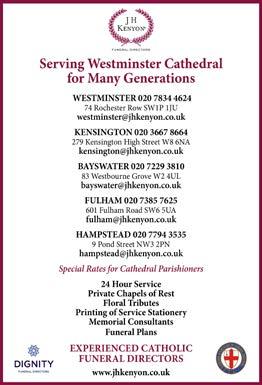
The war will finish. It’s a question of time. But hatred is not going to finish soon. We will need, especially after the war, the emotional space to talk about the future. Now everyone is so touched by the war that there is no emotional space to think about anything else. But in the end this will finish. When it does we’ll need to find people to help us to look beyond, to open our hearts to rebuild what this war has destroyed. Not only rebuild relations between Palestinians and Israelis, but also between Jews, Christians, and Muslims to rebuild the trust. We need people to help us to stand up, to raise our heads to see the presence of the cloud. God is present there. Maybe not in the big institutions – political, social, and religious – but at the grassroots level there are still many people, of all faiths, that are not afraid to do something for the other.
Where there is a gesture of love, a gesture of donation, a gesture of commitment towards the other, there Jesus is present. We have to pray for this. We have to pray that the Holy Spirit will give all of us this ability to raise our heads to see beyond destruction everywhere, to see how the Kingdom of God, despite everything, is still growing, still present in the ‘little ones’ of the Gospel.
I take a lot of consolation visiting the communities. I see how they suffer. They lost almost everything, especially in Gaza, they lost their houses, their opportunities. They have nothing. But they are not able to say a word of anger. They are not able to express hatred despite everything. They say this, ‘We are Christians. We have Jesus.’ They say this in a very simple way. They didn’t study the Christology of Karl Rahner; they are not professors. They are simple people, but they are attached to what is essential in their lives. Despite everything, they remain attached to their love for Jesus. We see very well how the love of Jesus is able to give them a vision of the situation which is sometimes quite different from ours.
My wish for all of us, is that we do not let the dramatic situations of the world determine our choices, our vision. We have to look to Jesus who comes in the Sacraments, in the Word of God, and in the occasions of life, so that we are able, with our heart and our eyes, to see, to look. We have to look. If you don’t look, you don’t find.
We must look for the sign of his presence everywhere, in our relationships first of all. Also, we count on your prayers because prayer is very powerful to help us see the coming of our Saviour, even in the Holy Land. We pray to be among those who want to build relationships, to help us not just to raise our heads, but to help all the people we meet to raise their heads to look together to the cloud, to the presence of God, and to develop relationships of friendship, fraternity, and humanity, especially in this moment where we try to dehumanise the other.
Although pilgrimages are totally cancelled, when the situation changes, I hope that we can see all of you in Jerusalem. We are waiting for you because your presence will bring joy, consolation, and happiness to many of our families.
Have a good Advent, a good preparation for the coming of our Saviour, and may the Lord bless all of us.
Under the Old Law every seventh year, like every seventh day, was always accounted holy and set aside for rest, but the year that followed seven complete cycles of seven years was kept as a sabbatical year of special solemnity. ‘Thou shalt sanctify the fiftieth year, and shalt proclaim remission to all the inhabitants of thy land: for it is the year of jubilee.’ (Lev. XXV. 10.)
This period of years was adopted by the early Christian Church probably for the same reason, namely, not merely because it represented half a century but because it was the year following seven cycles of seven years. But although this idea of solemnizing a fiftieth anniversary was familiar enough, it was not till the time of Pope Boniface VIII, in the year 1300, that the first celebration of a Christian Jubilee was recorded.
An important point to note is that, even before this time, the number fifty was especially associated with the idea of remission. It is in fact asserted that the proclamation of the first Christian Jubilee owed its origin to the evidence given by pilgrims that great indulgences had been granted them when visiting Rome at a similar period before; and a chronicler makes this entry under the year 1208: ‘It is said that this year was celebrated as the fiftieth year, or the year of jubilee and remission, in the Roman Court.’ In the first recorded Jubilee of 1300 Pope Boniface declares that he grants afresh and renews certain ‘great remissions and indulgences for sins’ which are to be obtained ‘by visiting the city of Rome and the venerable basilica of the Prince of the Apostles.’ And from that time to our own day, the Jubilee, or ‘Holy’ or ‘Golden’, year has been celebrated in similar fashion.
Boniface intended for the Jubilee Year to be celebrated only once in a hundred years, but later on objections were made, on the ground that the average span of life was short, so that the second Jubilee was celebrated in 1350. The next took place in 1390, when it was proposed that in future the Jubilee should take place every thirty-three years, representing the period of our Lord’s life on earth. The next accordingly was celebrated in 1423, but Pope Nicholas V held another in 1450 and reverted to the previous period of fifty years. Pope Paul II (1458-1464), however, decreed that the Jubilee Year should take place in future every twenty-five years, and this has been the normal rule up to our own Jubilee or Holy Year of 1925.
From the Westminster Cathedral Chronicle, January 1925
On Saturday, 4 December, Cardinal Griffin presided at a ceremony in the crypt of Westminster Cathedral when a Lieutenancy for the ancient Equestrian Order of the Holy Sepulchre of Jerusalem was set up for England and Wales.
The Brief formally inaugurating the new Lieutenancy was read by Father Bede MacEachen SA, who had travelled from Rome to represent Cardinal Canali, the Grand Master of the Order. Father MacEachen also read a Brief appointing Bishop Cowderoy of Southwark Grand Prior of the Lieutenancy, and a further Brief appointing Mr James Walsh PHD, KCSG, Lieutenant.
The Equestrian Order of the Holy Sepulchre of Jerusalem is many hundreds of years old. In the Holy Year 1950, a new Constitution was given to the Order by the Holy See, and Cardinal Canali was appointed by the Pope to be the Order’s Grand Master. In a preface to the Constitution, Cardinal Canali writes:
‘The Holy Father Pius XII in His Apostolic Brief Quam Romani Pontifices also gives to the Order a commission that is most noble and never diminishing, in His confidence that “Crusaders of our day” will proffer “to Us and to the Universal Church all those services and aids, whether spiritual or temporal, which appear more opportune and necessary to protect the Holy Places of Palestine and to liberate them from the power and attacks of both heretics and infidels”. Perhaps never before have so many solemn documents from a single Pontiff, and for the same scope, followed one another in so short a time in the Acts of the Apostolic See as those which the Holy Father Pius XII has addressed to the Catholic world Pro Sacris Palestinæ Locis in order to arouse prayers and assistance for the land of Jesus. It is indeed a title of highest privilege for the Equestrian Order of the Holy Sepulchre of Jerusalem to be called upon to array itself in the first ranks of this Crusade of faith, of prayer, and of charity, proclaimed by Pius XII with all the apostolic ardour of the Popes of the Crusades and of Peter the Hermit.’
To further this modern ‘Crusade’, and to help the Holy See in the upkeep of the shrines, Lieutenancies are being set up in various countries.
From the Westminster Cathedral Chronicle, January 1955
Thanks to Cora Emflorgo and her team, the Filipino Club began the pre-Christmas social season with typical glamour and flair, filling Cathedral Hall with music, food and dance..
Name

The annual Christmas fair was a huge success, with lots of prizes and seasonal goods. Thank you to all who worked so hard to make it such a triumph.

Maintenance and their (somewhat willing) volunteers were busy installing the two cribs and the two trees.


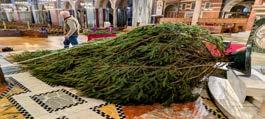
Congratulations to all of our altar servers who received Guild medals for the Archconfraternity of St Stephen. Particular congratulations to Hannah Boyle, pictured with her father David and the Dean, who received a silver medal for 10 years’ service.

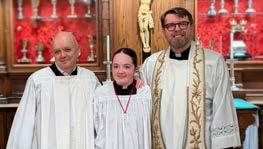
Along with a host of primary schools and angels, we were joined by Clover the donkey from Hackney City Farm, for the annual Catholic Children’s Society Advent service.

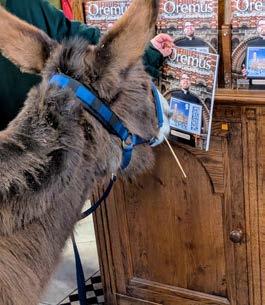
This year, the Polish Catholic Mission in England and Wales celebrated their 130th anniversary. As part of the celebrations, a Polish carol service was held in the Cathedral.

At the London Fire Brigade carol service, we were joined by a special guest, HRH Prince Michael of Kent, Royal Patron of the Children’s Burns Trust.

Friday 4th January 1935
On New Year’s Day 1935, the reign of Cardinal Francis Bourne, Westminster’s longest serving Archbishop (1903-35), came to an end; the only Archbishop not to be interred in Westminster Cathedral.
Although his body is buried at the former diocesan seminary of St Edmund’s, Ware, his heart was preserved at St John’s Seminary, Wonersh in Surrey, where he had been the first Rector. When the seminary closed in 2021, the heart was moved in its container to the vault at St George’s Cathedral, Southwark, where previous bishops and archbishops of that diocese are interred.
The funeral Mass in January 1935 was celebrated by Archbishop Francis Mostyn of Cardiff, as the most senior Metropolitan Archbishop in England and Wales. Although the throne was vacant due to the death of Cardinal Bourne, it was occupied for the funeral Mass by one of the two visiting cardinals, (now Venerable) August Hlond SDB, Primate of Poland.
Following the customary five absolutions for a deceased bishop or archbishop in his own cathedral, Cardinal Bourne’s body was taken to Ware for burial, which took place in the Galilee Chapel in front of the altar (pictured). The re-interment of his heart in the vault at St George’s Cathedral took place in 2022.

Sources:
The Tablet Westminster Cathedral Chronicle , February 1935
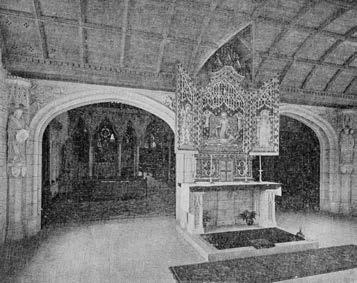

The Diocese of Westminster welcomes very warmly the news that Blessed Carlo Acutis will be canonised by Pope Francis in Rome on 27 April 2025. Blessed Carlo’s bonds with Westminster run deep. Born at the Portland Clinic in 1991, he was baptised in Our Lady of Dolours, Fulham Road.
His grandparents, Carlo Acutis and Maria Perlowska, were married in Westminster Cathedral in 1963. We recently discovered their entry in the Cathedral Marriage Register (pictured). They would have been deeply moved, surely, to know that two thousand people gathered recently in this same Cathedral, to venerate the relic of their grandson as we prayed for Blessed Carlo to come alongside us in adoration of the Most Holy Eucharist, as we celebrated our Eucharistic Festival.
Carlo used to describe the Eucharist as a ‘highway to heaven’. ‘The more we receive Jesus,’ he used to say, ‘the more we become like Jesus.’ Carlo is an inspiration not only to the young but to all generations in his devotion to the Blessed Sacrament.

But the young have, quite rightly, a special claim on him. For he will be the first millennial saint to be canonised; he is of their generation and era. He was only fifteen when he died. A genius with the computer, he harnessed this new technology to the creation of a remarkable website which presents Eucharistic miracles from across the globe. There is something deeply fitting about Pope Francis’ choice to canonise Carlo during the Jubilee of Teenagers next April, in St Peter’s Square, Rome.
I found myself near to the church of Carlo’s baptism when I received the news of a date for his canonisation, and so I entered Our Lady of Dolours. I was moved to find myself alone and standing beside the font where Carlo began his Christian journey some 33 years ago. I gave thanks to God for the extraordinary gift of Carlo to the Church and to the world.
I asked Carlo’s intercession for this Diocese of Westminster especially, the place where he was led down into the waters of baptism; and asked his prayers that he might help each one of us to make the Eucharist our ‘highway to heaven’, and so grow to ‘become like Jesus’ too.

The Voice of the Preacher, Blessed Thomas Plumtree
A scholar of Corpus Christi College, Oxford, in 1546 he was made the Rector of Stubton in Lincoln. He resigned his benefice on the change of religion under Elizabeth. But it is as chief chaplain and priest of the army of the Rising that he won the martyr’s palm. His voice seems to have been like the Baptist’s and to have stirred high and low alike. His call to abandon heresy and to rally to the standard of the faith ran through the northern counties, and hundreds came in response to his summons. On the gibbet in the market-place at Durham he was offered his life if he would embrace heresy, but he refused, and dying to this world received eternal life from Christ on 4 January 1572.
The Holy Father’s Prayer Intentions
For the right to an education
Let us pray for migrants, refugees and those affected by war, that their right to an education, which is necessary to build a better world, might always be respected.
Wednesday 1 January 2025
SOLEMNITY OF MARY, THE HOLY MOTHER OF GOD
(Bank Holiday timetable: Masses at 10.30am, 12.30 and 5.30pm)
Thursday 2 January
Ss Basil the Great and Gregory Nazianzen, Bishops & Doctors
Friday 3 January Friday abstinence
Christmas feria (The Most Holy Name of Jesus))
Saturday 4 January Ps Week 3
Christmas feria
4pm Low Mass (Blessed Sacrament Chapel) 6pm Vigil Mass of the Epiphany
Sunday 5 January
THE EPIPHANY OF THE LORD Choral services resume
12 noon Solemn Mass (Men’s voices)
Palestrina – Missa O magnum mysterium
Palestrina – Surge illuminare Ierusalem
Palestrina – Et ambulabant gentes
Organ: Cochereau – Toccata ‘Marche de Rois’ 4pm Solemn Vespers and Benediction
Bevan – Magnificat primi toni
Palestrina – Videntes stellam Magi
Organ: Messiaen – Les Mages (La Nativité) 4.30pm Mass for the Deaf Community (Cathedral Hall)
Monday 6 January
Christmas feria
5.30pm Diocesan Opening Mass of the Jubilee Year (Cardinal Nichols)
Tuesday 7 January
Christmas feria (St Raymond of Penyafort, Priest)
The Cathedral is open from 7.30am and closes in time for 7pm.

Monday to Friday: Morning Prayer 7.35am, Mass 8am, Mass (Latin, unless there is a Funeral) 10.30am, Confessions 11.30-12.30pm, Mass 12.30pm *, Exposition of the Blessed Sacrament 1.15-4.30pm, Benediction 4.30pm, Confessions 4.30-5.30pm, Sung Vespers 5pm (Latin, Choir, except Tuesday, English, Cantor), Solemn Mass 5.30pm (Choir, Tuesday: Boys’ voices, Wednesday: Men’s voices)
Saturday: Mass 8am, Morning Prayer 10am, Mass 10.30am (Latin, Choir,) Confessions 11.30-12.30pm, Mass 12.30pm *, Confessions 5-6pm, Sung Vespers 5.30pm (English, Cantor), Sung Mass 6pm.
Sunday: Mass 8am, Sung Morning Prayer 9.30am, Sung Mass 10am, Confessions 10.30-12.30pm; Solemn Mass (Choir) 12noon *, Solemn Vespers (Choir) and Benediction 4pm, Confessions 5-6.45pm, Sung Mass 5.30pm, Mass 7pm.
For full opening and closure times of the Cathedral and for confession and service times please consult the Cathedral diary on the website.
* Live streamed via the Cathedral website
Wednesday 8 January
Christmas feria
Thursday 9 January Christmas feria
Friday 10 January Friday abstinence Christmas feria
Saturday 11 January Christmas feria

Sunday 12 January
THE BAPTISM OF THE LORD 12 noon Solemn Mass (Full Choir) Mozart – Missa brevis in D major Palestrina – Tribus miraculis Organ: Widor – Finale (Symphonie II) 4pm Solemn Vespers and Benediction Victoria – Magnificat septimi toni Handel – And the glory of the Lord Organ: J S Bach – Christ unser Herr zum Jordan kam (BWV 684)
Monday 13 January Ps Week 1 Feria (St Hilary, Bishop)
Tuesday 14 January Feria
Wednesday 15 January Feria
Thursday 16 January Feria
Friday 17 January Friday abstinence St Anthony, Abbot
Saturday 18 January (Octave of Christian Unity)
Blessed Virgin Mary on Saturday 6pm Vigil Mass with Adult Confirmations
Sunday 19 January Ps Week 2 2nd SUNDAY IN ORDINARY TIME
Oremus
2025
12
noon Solemn Mass (Full Choir)
Rheinberger – Cantus missæ
Palestrina – Iubilate Deo universa terra
Organ: Reger – Toccata & Fugue in D (Op. 59, viii/ix)
4pm Solemn Vespers and Benediction
Palestrina – Magnificat primi toni
Allain – Cana’s Guest Organ: Vierne – Cathédrales
Monday 20 January
(St Fabian, Pope & Martyr; St Sebastian, Martyr)
5.30pm Mass attended by the Catenians, City of London (Bishop Curry)
Tuesday 21 January
St Agnes, Virgin & Martyr
5pm The Choir of St Paul’s Cathedral sings Evensong 6pm Said Mass
Wednesday 22 January Feria
(St Vincent, Deacon, Martyr)
Thursday 23 January
Friday 24 January Friday abstinence
St Francis de Sales, Bishop & Doctor
5pm The Choir sings Solemn Vespers at St Paul’s Cathedral
5.30pm Said Mass

Saturday 25 January
(Octave of Christian Unity ends)
The Conversion of St Paul the Apostle
Sunday 26 January Ps Week 3
3rd SUNDAY IN ORDINARY TIME
(OF THE WORD OF GOD)
12 noon Solemn Mass (Full Choir)
Palestrina – Missa brevis
Palestrina – Dextera Domini
Organ: Preston – Toccata
4pm Solemn Vespers and Benediction
Bevan – Magnificat tertii toni
G. Gabrieli – Iubilate Deo omnis terra
Organ: Messiaen – Le Dieu caché (Livre du Saint Sacrement)
Monday 27 January Feria
(St Angela Merici, Virgin)
Tuesday 28 January
St Thomas Aquinas, Priest & Doctor
Wednesday 29 January Feria
Thursday 30 January Feria
Friday 31 January Friday abstinence
St John Bosco, Priest
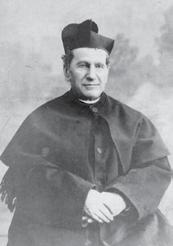

Key to the Diary: Saints’ days and holy days written in BOLD CAPITAL LETTERS denote Sundays and Solemnities, CAPITAL LETTERS denote Feasts, and those not in capitals denote Memorials, whether optional or otherwise. Memorials in brackets are not celebrated liturgically.
Catholic Grandparents’ Association
Hinsley Room,
Second Sundays 12-3.30pm
Charismatic Prayer Group
Cathedral Hall, Fridays 6.30-9pm
Divine Mercy Prayer Group
St Patrick’s Chapel, Sundays 1.30-2.30pm
Filipino Club
Cathedral Hall, Second Sunday 1-5pm
Guild of the Blessed Sacrament
Blessed Sacrament Chapel, Mondays 6.15pm
Guild of St Anthony Lady Chapel, Tuesdays 6.15pm
Interfaith Group Hinsley Room, Third Wednesdays 2-3.30pm
Legion of Mary Hinsley Room, Monday 1.30-3.30pm
Nigerian Catholic Association Hinsley Room, Fourth Sundays 1.30-2.30pm
Oblates of Westminster Cathedral Hinsley Room, Fourth Sundays 2.30-4pm
Padre Pio Prayer Group
Sacred Heart Church, First Thursdays 1.30-3.30pm
RCIA Group
Vaughan House, Tuesday 7-8.30pm
Rosary Group
Lady Chapel, Saturdays 11.15-12.00noon
Walsingham Prayer Group
St George’s Chapel, First Tuesdays 2.30-4pm
Yoruba Association Hinsley Room, Third Sundays 1.30-3pm
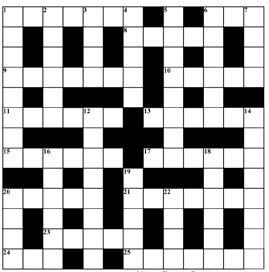
1 ‘Father -------’, Walter Scott’s fictional priest [Waverley Novels] (7)
6 --- -Rho, Greek letter used in symbol on, e.g., chasubles (3)
8 St. Thomas More’s son-in-law William, was good with lasso? (5)
9 Author of the seasonal classic A Christmas Carol (7)
10 & 11: ‘----- --- --- Wolf’: Prokofiev’s Symphonic Tale for Children (5,3,3)
11 See 10 Across
13 Prestigious London Boys’ Public School with R.C. chaplain (6)
15 ------ Holst, wrote St. Paul’s Suite for a London school (6)
17 ‘Tree’ in modern Hyde Park where numerous Saints were martyred (6)
20 Mount where Moses received the Ten Commandments (5)
21 Arts including judo and karate (7)
23 Recipient of a Pauline Letter (5)
24 River giving name to City and Cathedral (3)
25 Little villages with Shakespearian association! (7)
Clues Down
1 & 20 Down: Burns’ Song at the bringing in of the New Year (4,4,4)
2 Ready for attack in twos? (6)
3 Instrument in, e.g., London Philharmonic woodwind section (4)
4 Max, prolific surrealist painter and sculptor (5)
5 Feast of Revelation at end of Christmastime (8)
6 Common feature of the Moon (6)
7 First name of composer Stravinsky (4)
12 Flower and St. Dominic’s right-hand man at the founding of the Order (8)
14 Essential item for opening canal lock gates on way to Camden (8)
16 One of the Houses of the U.S. Congress (6)
18 ‘Hic et ------’, used in connection with new pope, ‘here and everywhere’ (6)
19 The, traditional Anabaptist community in the USA (5)
20 See 1 Down
22 Measurement of paper [in square amounts!] (4)
By John Keats
St Agnes’ Eve—Ah, bitter chill it was! The owl, for all his feathers, was a-cold; The hare limp’d trembling through the frozen grass, And silent was the flock in woolly fold: Numb were the Beadsman’s fingers, while he told His rosary, and while his frosted breath, Like pious incense from a censer old, Seem’d taking flight for heaven, without a death, Past the sweet Virgin’s picture, while his prayer he saith.
At length burst in the argent revelry, With plume, tiara, and all rich array, Numerous as shadows haunting faerily The brain, new stuff’d, in youth, with triumphs gay Of old romance. These let us wish away, And turn, sole-thoughted, to one Lady there, Whose heart had brooded, all that wintry day, On love, and wing’d St Agnes’ saintly care, As she had heard old dames full many times declare.
They told her how, upon St Agnes’ Eve, Young virgins might have visions of delight, And soft adorings from their loves receive Upon the honey’d middle of the night, If ceremonies due they did aright; As, supperless to bed they must retire, And couch supine their beauties, lily white; Nor look behind, nor sideways, but require
Of Heaven with upward eyes for all that they desire.
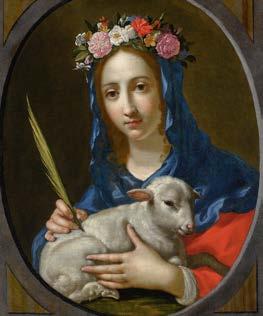
To submit a poem whether by yourself or another for consideration, please contact the Editor – details on page 3.
Ad Fontes

The organ stands at the spiritual heart of music heard in French Catholic liturgy. In this disc, Peter Stevens invites us to encounter two contrasting titans of this world, César Franck and Charles Tournemire, at one time teacher and pupil, who forged compositional idioms that continue to dominate the world of the organ and its use as an instrument capable of inflecting the spiritual sensibilities of French culture. The Trois Chorals of Franck are three fantasies, in which swirls of colour, harmony and at times sheer virtuosity evoke heartfelt

emotional and spiritual convictions. Works from L’Orgue Mystique of Charles Tournemire build on this legacy, particular with its profound sense of metrical freedom, but root this deeply in the Church’s seasons and the rich inheritance of Gregorian chant. The grand organ of Westminster Cathedral gives voice to these masterpieces, in the hands of one of this generation’s finest exponents of the genre.
Released on Friday 17th January 2025. Available to pre-order now.
